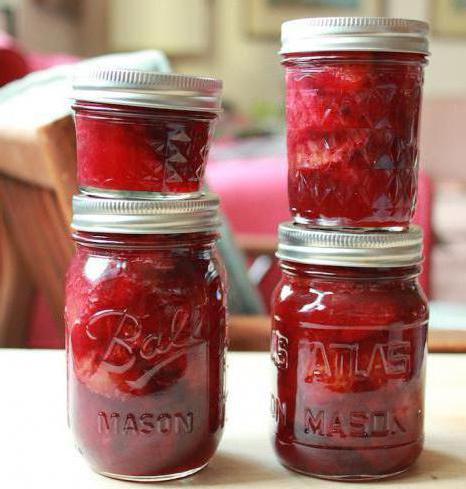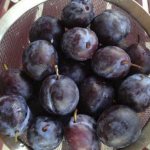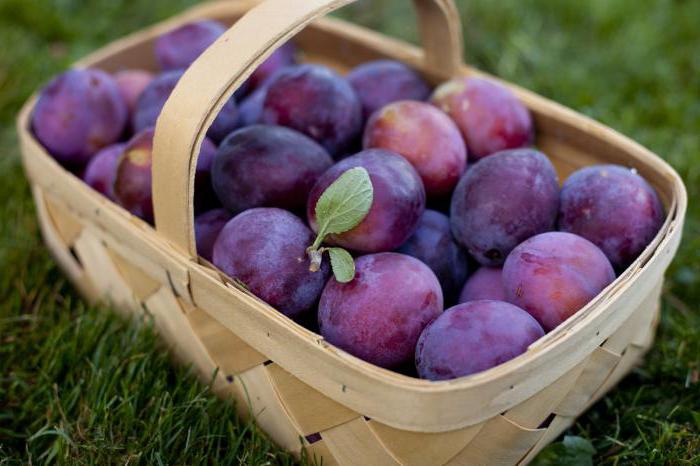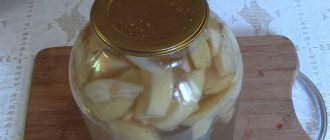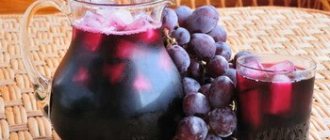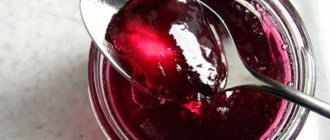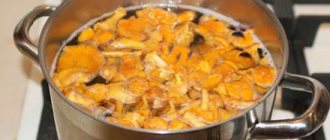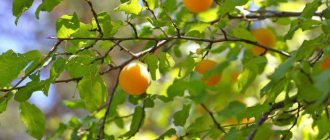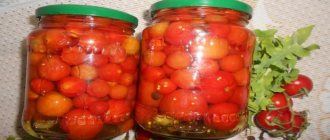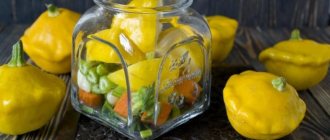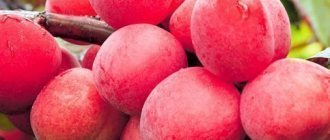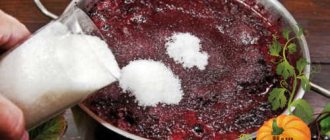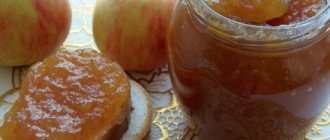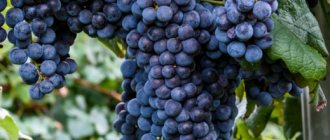How to make plum and apricot compote for the winter: a recipe without sterilization
Fruit requirements:
- fleshy, with a dense skin,
- size - medium or large,
- bone - small, easily detachable,
- degree of maturity - slightly immature or quite ripe - depending on the variety.
How to prepare fruits and jars for conservation, see the previous part of the article.
Fruit consumption per 0.5 liter jar: whole plums and apricots - 400 g.
Fruit consumption per 1 liter jar: whole plums and apricots - 700 g.
Important: it is recommended to cut large fruits after removing the bone.
Required amount of water for scalding:
- on a can of 0.5 l - 200-250 g,
- for a can of 1 l - 350-400 g.
Preservation of compote:
- Put the prepared fruits in jars tightly, but not crushing.
- Boil water for scalding. Pour boiling water over the jars to the very top. Let stand for 10-15 minutes.
- Drain the water and use it to prepare sugar syrup at the rate of 400 g of sugar for every 600 g of water. Pour the boiling syrup over the jars.
- Cork hermetically.
Important: if the plums are too sweet, add citric acid to the syrup at the rate of 1 tsp. or 5 g of citric acid per 2.5 liters of syrup.
Features of cooking prunes
To create a dessert, it is better to choose large berries. It is advisable to use fruits that have a dark skin, and the weight is 35-40 g.
If the plums are large, then the seeds should be removed. But even in small and medium-sized fruits, it is advisable to eliminate them. If you cook the fruits on a baking sheet, then it is advisable to spread them with the cut up.
Although a lot of time is spent on the creation of prunes, the result is still justified. After all, there will be no chemistry in this product, therefore it is absolutely safe for humans.
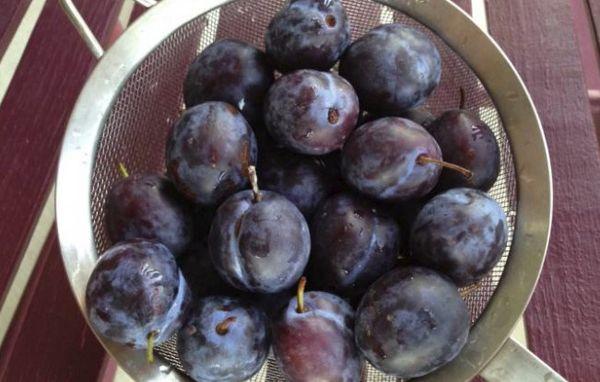
How to make plum and peach compote for the winter: a recipe without sterilization
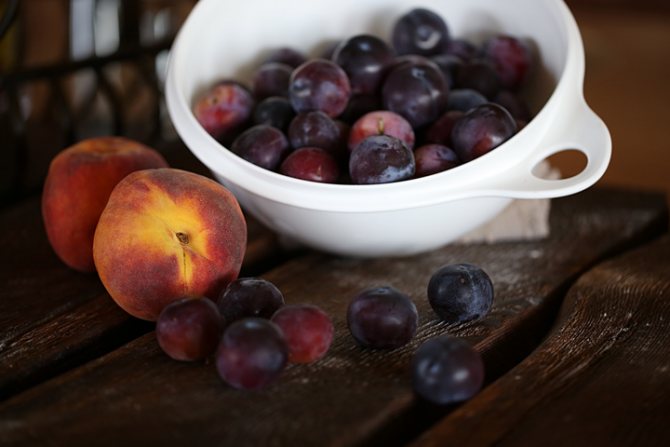

Washed fruit before peeling and placing in jars
How to prepare plums, see the beginning of the article.
The preparation of peaches for conservation is somewhat different, since the peels must be removed from the fruit. For this, the halves of the peaches are scalded with steam for 2-3 minutes, and then immediately doused with ice water. The skin can be easily removed without the use of any special tools. If the fruits for conservation are not very large and it is not advisable to cut them, let them blanch in boiling water for 40-60 seconds. Then also quickly chill in ice water and peel off.
Important: It is recommended that the fruits be kept in cold water at all times (even during cutting). This will keep them from darkening.
Fruit consumption per 0.5 liter jar: whole plums and peaches - 400 g.
Fruit consumption per 1 liter jar: whole plums and peaches - 700 g.
Important: it is recommended to cut large fruits after removing the bone. The consumption of cut fruits will be slightly higher than whole ones.
Required amount of water for scalding:
- on a can of 0.5 l - 200-250 g,
- for a can of 1 l - 350-400 g.
Preservation of compote:
- Put the prepared fruits in jars tightly, but not crushing.
- Boil water for scalding. Pour boiling water over the jars to the very top. Let stand for 10-15 minutes.
- Drain the water and use it to prepare sugar syrup at the rate of 400 g of sugar for every 600 g of water. Pour the boiling syrup over the jars.
- Cork hermetically.
Important: be sure to add citric acid to the syrup at the rate of 1 tsp. or 5 g of citric acid per 2.5 liters of syrup.
Dry (dry) plum
How to dry plums? A unique prune in the kitchen will always come in handy. Sun-dried plums contain many vitamins, various microelements, and antioxidants. The nutrients contained in the composition prevent the growth of bacteria that cause tooth decay. Such a healthy fruit must be prepared for the winter.
In order for the plum to dry properly and well, select only the ripe fruits that are falling from the tree or are about to fall. Not all varieties are successful for drying; Vengerka and plums with a high content of sucrose and pectin are the most suitable. An important condition for obtaining good prunes is the presence of dense pulp, good bone removal when pressed, the content of pectin and sugar in high quantities.
Healthy plums are selected, bones are removed, then the fruit must be blanched for 1-2 minutes in boiling water, then dipped in cold water and taken out, letting dry a little, remove excess liquid with napkins. To make prunes shiny and dark, plums are soaked in honey syrup (for one part of honey, take two parts of boiling water) for 3-5 minutes.
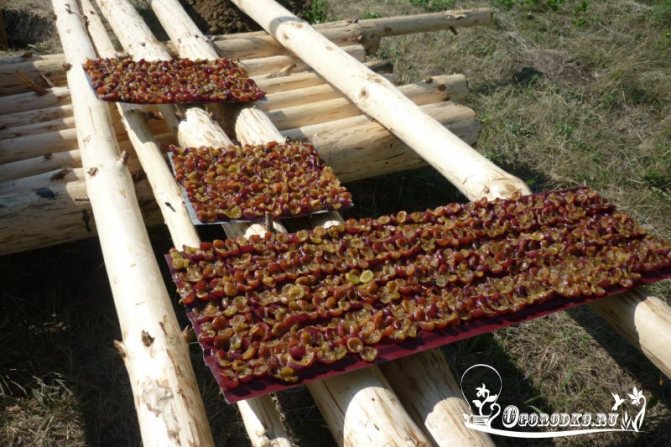

Credit:
You can dry it outdoors, in the sun, or use a special dryer, gas or electric oven. To dry in the sun, spread the cream on a tray or baking sheet in one layer, turning occasionally. The time spent in the sunlight is 4-5 days, at night you need to bring it indoors so that the fruit does not get damp. After the dew dries up, they are again exposed to the street. After the specified time, the prunes must be removed in the shade for drying for several days (usually 3-4).
When the prune is ready, when pressed, no liquid should be released, it should be elastic, not crumble in your hands. It is customary to add ready-made dried fruits to meat dishes, use for baking, preparing various desserts or spicing salads.
How to cook plum and apple compote for the winter: a recipe without sterilization
How to prepare plums, see the beginning of the article.
Requirements for apples:
- sweet and sour or sour with dense juicy pulp,
- size - medium or large,
- degree of maturity - slightly immature or quite ripe - depending on the variety.
Before putting them in jars, the apples are cut, cored, and the rough skin is removed. To avoid darkening, the fruit slices or halves are blanched in a citric acid solution (1 tsp citric acid per 3 l of water). The blanching time depends on the density of the apples: 5-10 minutes. at a temperature of 85 ° C.
If the apples are very sour, they should be pre-blanched in sugar syrup (300 g of sugar per 700 g of water). Blanching time: 4-6 min. at a temperature of 85 ° C. In this case, the compote is best preserved by sterilization.
Without sterilization, the compote is preserved with a scallop.
Required amount of water for scalding:
- on a can of 0.5 l - 200-250 g,
- for a can of 1 l - 350-400 g.
Preservation of compote:
- Put prepared fruits, apple slices and plums in jars tightly, but not crushing.
- Boil water for scalding. Pour boiling water over the jars to the very top. Let stand for 10-15 minutes.
- Drain the water and use it to prepare sugar syrup at the rate of 400 g of sugar for every 600 g of water. Pour the boiling syrup over the jars.
- Cork hermetically.
How to make plum and ranetki compote for the winter: a recipe without sterilization
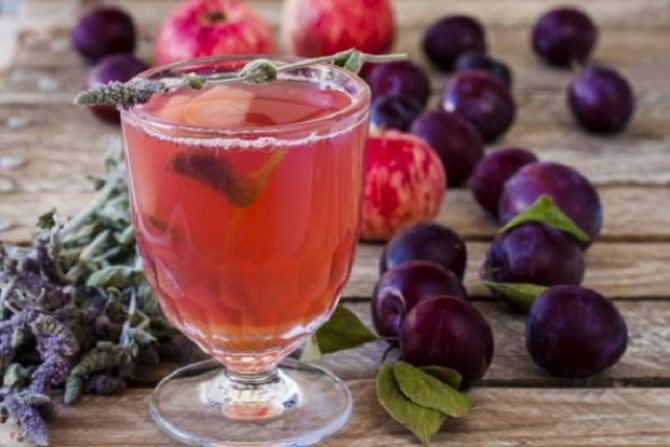

Plum and ranetka compote: serving example
The preparation of ranet apples requires special attention. They should be washed well, especially in the area of the receptacle and stalk. Next to the ponytail, make some deep punctures with a toothpick.
Then follow the recommendations indicated in the previous part of the article.
How to make mashed plums for the winter: a recipe
Fruit preparation:
- go over,
- rinse thoroughly in warm water to remove the wax film from the skin,
- remove bones.
Important: Do not use unripe, overripe, damaged or infected fruits.
How to prepare jars, see the beginning of the article.
Pureeing:
- Pour a small amount of ordinary drinking water into the container (height 2-3 cm). Lay out the prepared fruits.
- Boil the mass for 10 minutes until the fruits are completely softened.
- Rub the mass through a sieve or punch with a blender. In the second case, you run the risk of getting interspersed with spicy plum peel in a gentle puree. But it is she who gives the dish a very interesting sourness, and a recognizable aftertaste.
- The mashed mass should be brought to a boil over moderate heat. Be extremely careful and careful: the mass needs constant stirring to avoid burning. However, as it heats up, the puree may "spit" hot juice.
- Pack the boiling mass into jars and seal it hermetically.
Important: for the preparation of 1 kg of puree, you must use 1.2 kg of fresh fruit.
Plum marshmallow
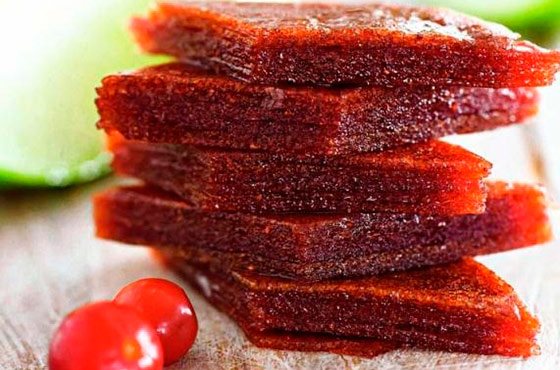

It should be made from very ripe yellow plums (cherry plums can be used).
Peel the plums and arrange in one layer (but tightly) on a baking sheet, bake at 150 degrees until the fruits become soft. Rub them through a sieve or mince them.
For every 3 cups of mashed potatoes, take 400 g of sugar, boiled and ground whole orange peel, a pinch of clove powder (or 3 flowers, but then you need to take them out) and cook, stirring with a spoon, so as not to burn.
Cook until the mashed potatoes begin to lag behind the walls of the vessel. Then take a piece of parchment (or linen), grease with refined oil, preferably olive oil, spread the marshmallow with a layer of about 3 cm, put a second layer of parchment on top, put a wooden chopping board, a press (a liter jar of water) on it and leave it for 6 days.
Then remove the top parchment and dry the marshmallow in the oven over low heat for 30 minutes - until a crust forms. This candy can be stored for a very long time in a dry place.
Canned plums in pitted syrup: a recipe
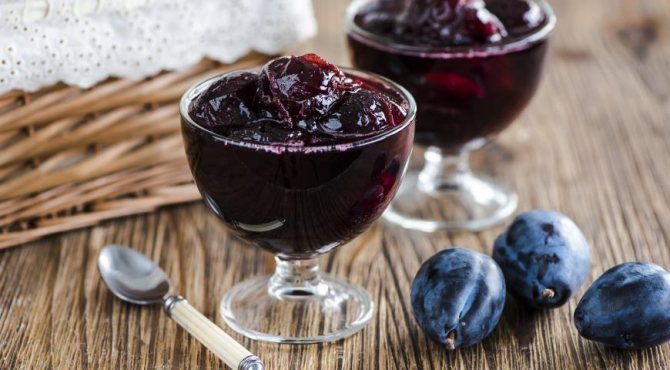

Plum in pitted syrup: serving example
Consumption of fruits and syrup per 0.5 liter jar:
- whole plums - 400 g,
- syrup 40% - 185-200 g.
Consumption of fruits and syrup per 1 liter jar:
- whole plums - 700 g,
- syrup 40% - 350-400 g.
How to make 40% syrup: mix 400 g granulated sugar and 600 g of ordinary drinking water in one container. Bring to a boil. Boil for 2-3 minutes. In the process of boiling, remove the resulting foam. The syrup yield from the above proportions is 850 g.
If the fruit is acidic, increase the sugar concentration to 45%. To do this, take 450 g of sugar and 550 g of water.
Preservation of compote:
- Put the prepared fruits in jars tightly, but not crushing.
- Boil water for scalding. Pour boiling water over the jars to the very top. Let stand for 10-15 minutes.
- Prepare syrup.
- Drain the water from the cans. Pour the syrup over jars of scalded fruits.
- Cork hermetically.
The original recipe for sweet prunes
To prepare such a delicacy, take 1 kg of plums, 0.5 kg of sugar, 400 ml of water.
- Peel the fruit, divide it into halves.
- Make a syrup, dip the plums in it, bring to a boil.
- Remove the plums, let the syrup drain, place them on a baking sheet, sprinkle with sugar.
- Preheat oven to 50 ° C. Perform a three-stage withering. The duration of each of them will be 12 hours. Take a break of 12 hours between them.
- Divide the sweetness into the jars. You can use it to prepare meals, drinks, or use it alone.
If you prepare a plum according to the recipes that we described above, you can enjoy a delicious healthy sweetness in winter, when the body is experiencing a lack of nutrients. Hurry up to harvest and start winter harvesting!
Canned plums in their own juice: a recipe
How to prepare fruits and jars, see the beginning of the article.
- Put the prepared plum wedges in jars, sprinkle each fruit layer with sugar. The ratio of fruit to sugar is 2: 1, i.e.to preserve 2 kg of fruit, 1 kg of sugar is required.
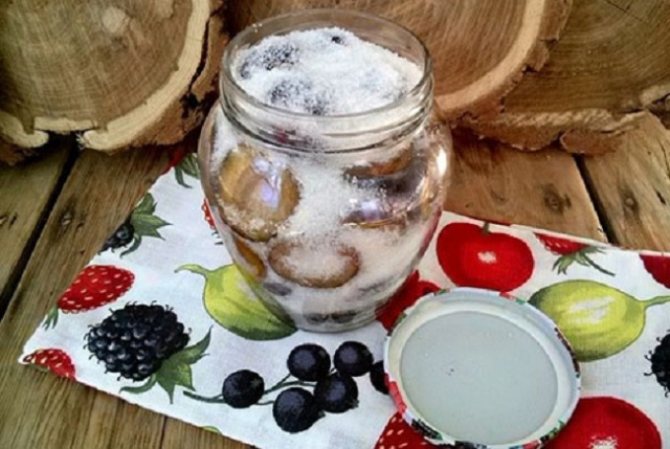

Jar with plums and sugar before sterilization
- Cover the jars with lids and send them for sterilization.
- As the sugar dissolves and the fruit subsides, add the plums and sugar until the jar is full. As soon as the juice in the jar rises to the extreme level and boils, take out the jars and seal them hermetically.
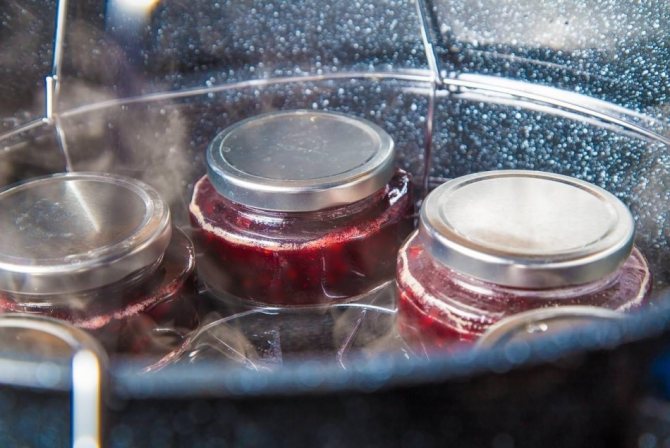

Plum in its own juice before clogging
Spicy green plum jam
A unique way of preserving plums is jam. The main feature is the use of green berries. To do this, process the fruits and pierce them with a needle, put them in an enameled stewpan, cover them with sugar and put them on low heat. When the granulated sugar begins to melt, add water, stirring the jam thoroughly. It is necessary to cook the plums until the sugar is completely dissolved and the berries acquire a sweetish tart flavor.
The finished product must be laid out in a container, closed with a plastic lid and stored. Before removing the jam from the heat, you need to taste the fruit. Someone prefers that the plums remain sour and tart, while others want to add more sweetness and wait until the berries become soft and crumbly.
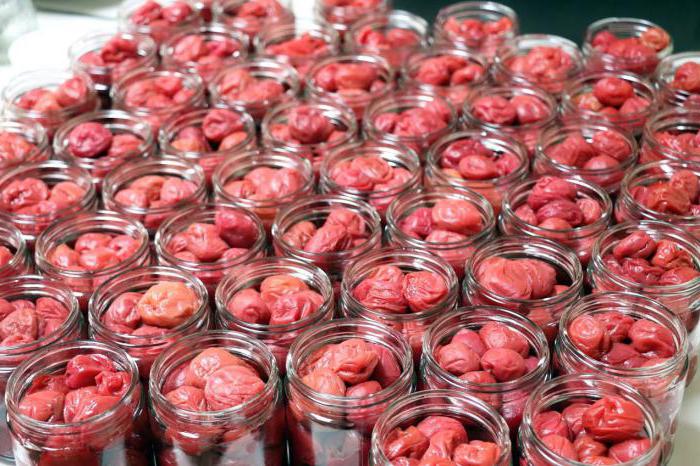

How to make canned sugar-free plums for the winter: a recipe
The preparation of fruits and jars is described at the beginning of the article.
For a 1 liter jar, you will need 1 kg of sweet plums with firm pulp.
Jars, at least 2 pieces, should be tightly filled with plum wedges, laying the fruit cut down.
Sterilize within 20 minutes.
As soon as the fruit begins to shrink, transfer the fruit from one jar to another. Be sure to make sure that the spoon you use to transfer the fruit is clean.
After the fruit is compacted, sterilize the jars for another 10 minutes and seal tightly.
We sterilize containers
Banks and lids for the workpiece are thoroughly washed with hot water and sterilized in a convenient way:
- The container with water is brought to a boil, a colander is installed, in which the jars are placed for sterilization with the neck down. The processing time of the cans is kept within 15-20 minutes.
- The washed containers are sent to an oven preheated to 150 degrees, where they are left for 10-15 minutes.
- Also, jars can be sterilized in a microwave or double boiler.
The lids for sealing containers are boiled in ordinary water for 5-10 minutes.
Plums, mashed with sugar: a recipe
The method of preparing raw jam has its own subtleties that must be taken into account if you want to get a tasty and healthy product, and not a "drunken" mixture and spoiled mood.
Fruit requirements:
- fresh! Ideal - only from a tree,
- maturity - quite mature.
Important: it is absolutely impossible to use unripe, overripe, damaged or infected fruits.
The dishes that you use to make raw jam should be rinsed with boiling water and dried. Banks must be washed and sterilized. For methods of sterilizing cans, see the beginning of the article.
The fruit follows
- go over,
- sort by color, size and degree of maturity,
- wash with warm water until the natural wax coating is removed from the surface of the skin, and then pour over with boiling water,
- remove bones,
- blend together with granulated sugar. Sugar is added to the mixed fruit mass at the rate of 1: 1, that is, for 1 kg of fruit you need 1 kg of granulated sugar.
Put the fruit mass in dry jars. Pour granulated sugar on top, creating a kind of sugar layer 0.3-0.5 mm thick.
Seal with metal or nylon caps.
This jam is stored exclusively in the refrigerator!
Tip: If you have a freezer, raw jam can be packed in plastic trays and stored there. Frozen jam needs to be thawed before use.
Tkemali sauce
Not a single feast is complete without the famous sauce in Georgia.Traditionally, tkemali is made from unripe or red cherry plum. But if cherry plum is not at hand, a sauce that tastes very good can be made from any sour plums.
For 1 kg of fruit, you will need one large bunch of cilantro and dill, a head of garlic, 2 tsp. seasonings "khmeli-suneli", 3 tbsp. l. granulated sugar, 1 hot pepper and salt. Plums are placed in water, brought to a boil, removed and allowed to settle in hot water for a little while to soften. After that, seeds are removed from the plums, and the berries are crushed with a blender into a homogeneous mass.
Cilantro and dill are finely chopped. Garlic is peeled and crushed in a mortar with hot pepper and salt. Plum puree is mixed with chopped grass and heated in a saucepan over low heat, not forgetting to stir. Before boiling, put garlic with pepper, sugar and "hops-suneli" in the sauce. If you wish, you can also put coriander and finely chopped mint there. Tkemali is worth trying and, if necessary, add some salt. If the sauce turns out to be very sour, add more granulated sugar to it. Tkemali is boiled for a short time - only 5-7 minutes in order to preserve more nutrients and vitamins. The hot sauce is poured into wide-mouth jars and stored in the refrigerator.
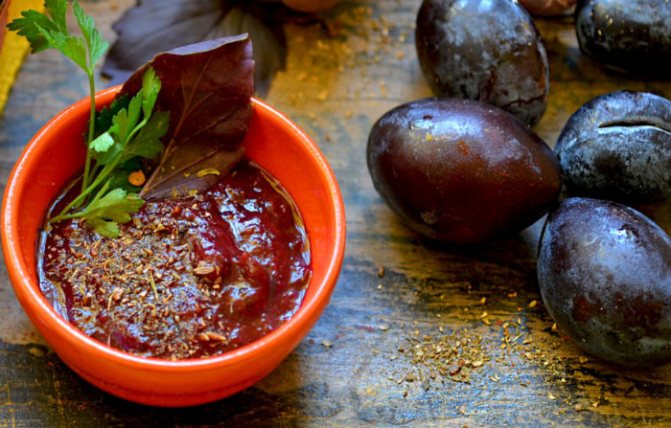

How to make pickled and salted plums for the winter: a recipe
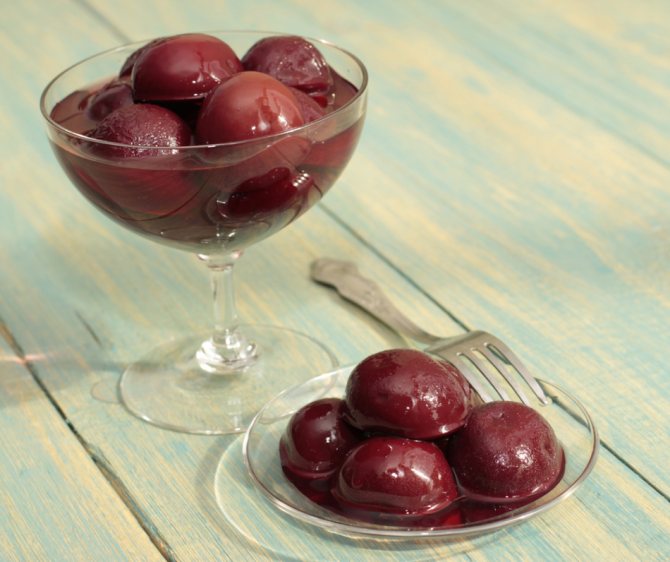

Soaked plum: serving example
Fermentation and pickling are based on the same natural fermentation processes. But we salt the vegetables, and we wet the berries and fruits. Therefore, one of the recipes presented below is suitable for peeing / salting plums.
For peeing, Hungarian or blackthorn plums are suitable. If these varieties are not available, give preference to slightly unripe fruits with very dense skin.
How to properly wash the fruit before preserving, see the beginning of the article.
Important: before putting in a jar, the fruits should be well dried and pierced with a toothpick in several places.
Consumption of fruits and brine per can of 1.5 liters:
- whole plums - about 1 kg (the amount of fruit depends on the density of the fruit packing),
- brine - 1 liter (the amount of marinade depends on the density of the fruit laying).
How to make a marinade:
- Mix in one container ordinary drinking water 1 l, table salt (not iodized) 15 g, granulated sugar 50 g, bay leaf - 10 g.
- Boil. Boil for 2-3 minutes. In the process of boiling, remove the resulting foam. Cool to room temperature.
How to cook:
- Put the prepared fruits in a jar up to "shoulders". Pour 20 g mustard powder on top and put cherry or currant leaves (to the top).
- Pour marinade to the brim. Cover with a nylon lid and leave in a dark place for fermentation. To prevent the marinade from leaking out during fermentation, place a deep bowl or plate under the jar.
- Fermentation time from 3 to 10 days (depending on the temperature in the room and the ripeness of the fruit).
- After the plums have passed the initial stage of fermentation, close the jar with a nylon lid, send to the refrigerator and leave for 20-30 days to ripen.
Selection and preparation of main ingredients
For the preparation of pickled prunes, choose hard, sweet varieties of plums. The dark blue fruits of the Vengerka variety are most suitable for harvesting for the winter.
- Fruits are sorted out for tough, slightly unripe fruits.
- Next, the plum is washed under running water, the stalks are cut off.
Important! Soft fruit varieties will crack and turn into a puree when preserved.
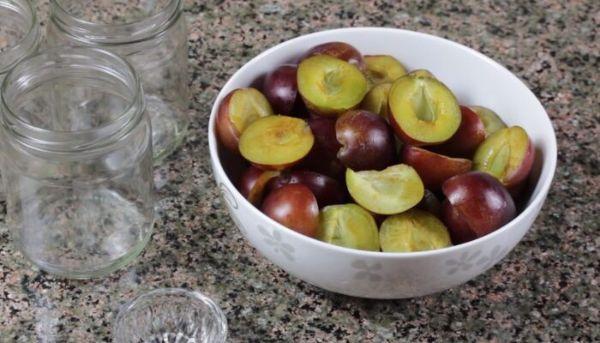

How to make pickled plums with garlic for the winter: a recipe without sterilization - a recipe
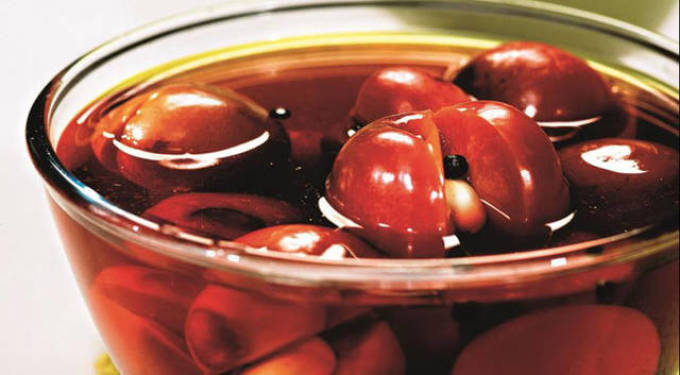

Pickled plum with cesk in a glass container
How to properly wash fruits before preserving, see the beginning of the article.
Important: before laying in a jar, the fruits should be well dried and pierced with a toothpick in several places.
Consumption of fruits and marinade per can of 1.5 liters:
- whole plums - about 1 kg (the amount of fruit depends on the density of the fruit packing),
- marinade - 1.1-1.3 l (the amount of marinade depends on the density of the fruit laying).
How to make a marinade:
- Mix in one container ordinary drinking water 780 g, granulated sugar 460 g, table vinegar (9%) - 90 ml, spicy cloves - 4 pcs., Allspice - 3 pcs.
- Boil. Boil for 2-3 minutes. In the process of boiling, remove the resulting foam.
How to pickle:
- Using a neat cut, remove the pits from the plums. Instead of the seed, put a peeled clove of garlic.
- Put the plums stuffed with garlic in a jar up to the "shoulders".
- Pour over boiling marinade. Let it brew for 12 hours.
- After 12 hours, drain the marinade, bring to a boil and refill the jars with it.
- Cork hermetically.
Prunes in an electric dryer
Before laying the fruits in an electric dryer, they are prepared similarly to the previous recipes, that is, they are sorted out and washed. If the plum withers entirely, then the fruits must be blanched in a soda solution, but if you divide them into halves and remove the seeds, you can do without blanching. Cooking prunes:
- at the first stage, the plums are dried in an electric dryer at t ° 50 ° C for 3-4 hours, after which they must be cooled. If the fruits, divided into halves, can be processed, they are laid out in slices up;
- the second stage is drying the fruits in an electric dryer at t ° 60 ° C for another 5 hours, after which the fruits must be cooled again;
- the third stage is drying at t ° 80 ° C for 6 hours.
Attention! In order for the fruit to dry evenly, it is necessary to periodically change the pallets in places.
The prunes prepared in this way should also be stored in jars, in ventilated areas. You can use the finished product when preparing other dishes or as an independent delicacy.
How to make pickled plums with mustard for the winter: a recipe without sterilization: a recipe
How to properly wash fruits before preserving, see the beginning of the article.
Important: before laying in a jar, the fruits should be well dried and pierced with a toothpick in several places.
Consumption of fruits and marinade per can of 1.5 liters:
- whole plums - about 1 kg,
- marinade - 1.1 l (the amount of marinade depends on the packing density of the fruit).
How to make a marinade:
- Mix in one container ordinary drinking water 1 l, table salt (not iodized) 15 g, granulated sugar 75 g, table vinegar (9%) - 56 ml, spicy cloves - 4 pcs., Allspice - 5 pcs., Black pepper - 10 pcs., Bay leaf - 1 pc., Ground cinnamon - 4 g.
- Boil. Boil for 2-3 minutes. In the process of boiling, remove the resulting foam. Cool to room temperature.
How to pickle:
- Put the prepared fruits in a jar up to "shoulders". Sprinkle 20 g mustard powder on top.
- Pour marinade to the very edge. Cover with a nylon lid and leave in a dark place for fermentation. To prevent the marinade from leaking out during fermentation, place a deep bowl or plate under the jar.
- Fermentation time from 3 to 10 days (depending on the temperature in the room and the ripeness of the fruit).
- After the fruits have passed the initial stage of fermentation, the jar should be sealed with a nylon lid, sent to the refrigerator and left for 20-30 days to ripen.
How to keep plums fresh for the winter?
The most affordable way is freezing.
Put the prepared fruits in one layer and cool for 60 minutes in the main compartment of the refrigerator, and then move to the freezer. The fruits are frozen within 2-3 hours. After that, they can be transferred to hermetically sealed bags or plastic trays.
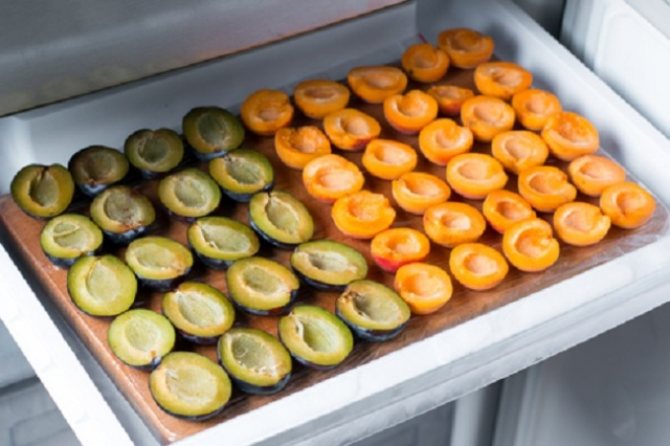

Plum and apricot wedges before freezing
How to make sauces from berries and fruits, including tkemali from plums, read here.
Application of berries
Plum has long been used as a laxative, because the berry helps to improve intestinal motility, relieve constipation and cleanse the body of heavy metals and toxins that enter us through water and food.In addition, the fetus effectively fights spasms by relaxing the smooth muscles. Today, people use the berry for both medicinal and culinary purposes. For the prevention of diseases, the leaves and bark of the plant are used. Juicy sweet fruits are eaten. Berries make not only delicious jam and fragrant compote, but also candied fruits, marmalade. Let's find out how to preserve the taste and healthy complex of vitamins with the help of recipes for preserving plums for the winter.
